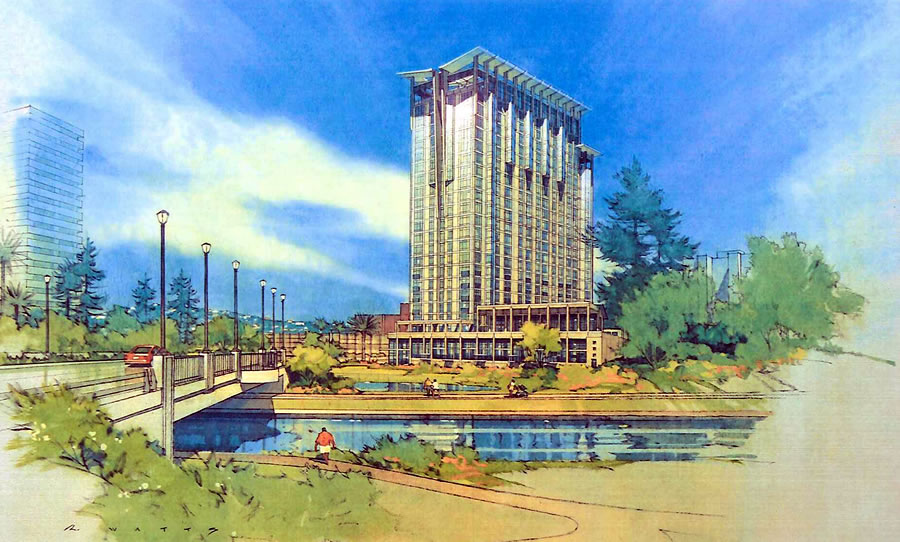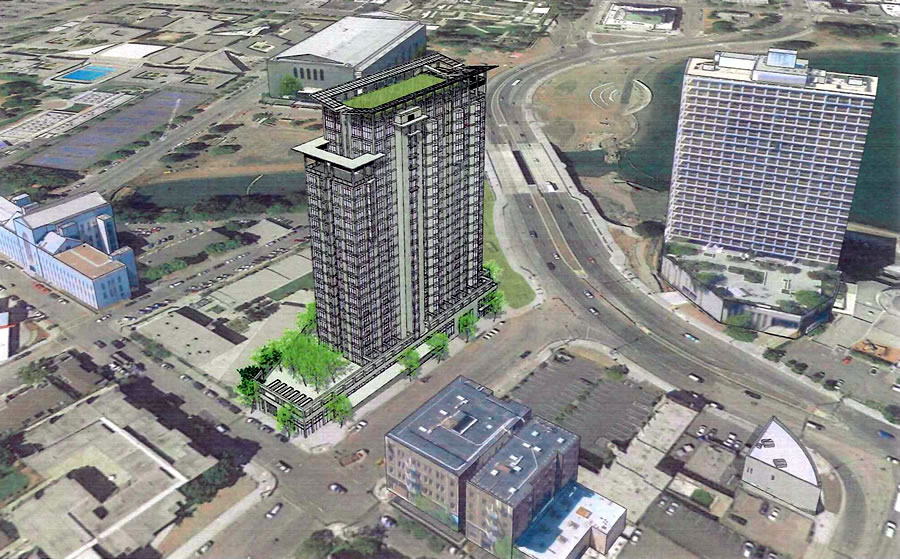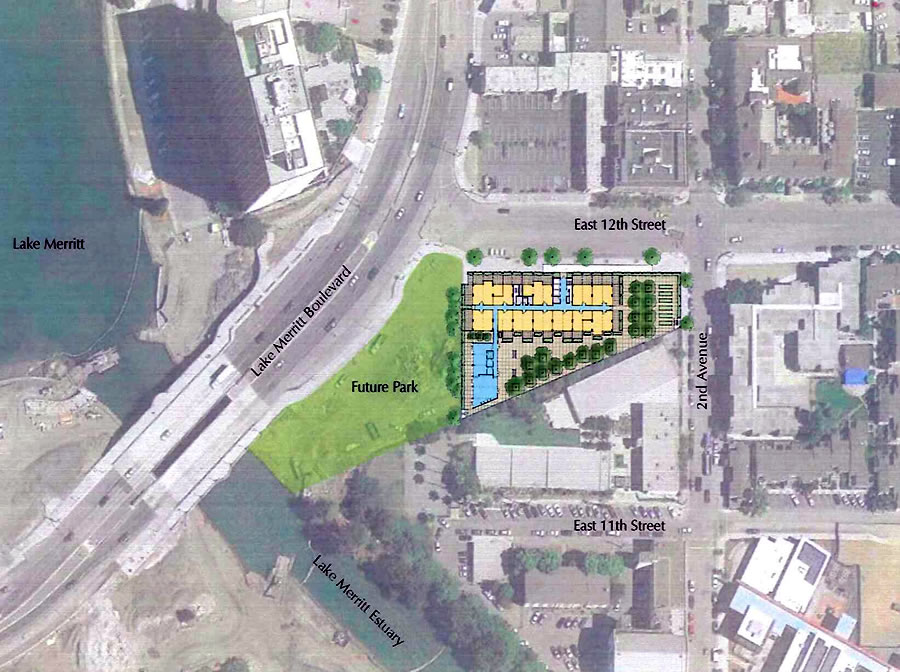Oakland’s City Council has approved the sale of the East Lake development site at the corner of East 12th Street and 2nd Avenue which overlooks Lake Merritt and its estuary, clearing the way for a controversial 23-story building with 298 apartments to rise.
UrbanCore will pay the city $5.1 million for the property as originally agreed, and will also pay a newly negotiated $8 million into the city’s affordable housing fund, but will not include any below market rate apartments within the development. Rents at the Lake Merritt Boulevard Apartments project are currently projected to average $3,000 per month.
The development, which will rise across the estuary from Oakland’s shuttered Convention Center which is slated to be redeveloped as well, will include parking for 209 cars, a 2,000-square-foot café on the ground floor of the building and landscaping improvements to the City-owned stormwater treatment basin (“park”) that’s adjacent to the building site.
Neighborhood opposition fears that the development will lead to a rise in area rents and accelerate the gentrification of Oakland and the East Lake neighborhood.
Construction will take around two years to complete once the ground has been broken.



Yay! Oakland on the rise!
Hopefully this will shut up the militant [activist] crowd for a short while.
Or you.
“Neighborhood opposition fears that the development will lead to a rise in area rents”
yeah, because NOT building new units will lower rents for sure.
Does nobody even take basic economics anymore? Supply/Demand curve anyone?
Watching the open session was a circus: one ideological group after another. Race, class and xenophobia were the topics of the night with many trying to prove they were the most downtrodden. Even the developer was made out to be a victim of racism. Whether the vote leads to a court battle or not I was impressed with the council (mostly) not taking the bait.
It’s really not that simple and a truly basic understanding of economics is leading many people astray. The demand curve isn’t static and a greater supply of higher-end units within an existing neighborhood shifts the demand curve as the area becomes more desirable, typically raising overall rents and prices despite – and actually directly due to – the new supply.
Prove it. Cite one legitimate academic analysis of that conclusion. Apparently housing, in your mind, has an entirely different set of economic principles.
um there’s this guy named Shiller who has shown rather conclusively that simple supply-demand doesn’t explain the cost of housing. If you’d like a fuller explanation, his Nobel Prize acceptance speech is online and he and others have published extensively on this. BTW, he is the Shiller of the Case-Shiller indices. He has huge volumes of data to back him.
@Grubber2: It’s called “gentrification” and it shifts the price of everything upwards. Over a short period of time, this city is engaged converting its housing stock from “something for everyone” into a *gated community*. For many people currently living in San Francisco, it won’t matter how much new supply is provided if it is all provided at much higher prices.
It isn’t a matter of housing having “an entirely different set of economic principles”. It’s about properly understanding economic principles and how they apply. As far as “proof” goes, I have seen none of that from the fundamentalists here who believe that the market knows best, always sorts things out for the greatest good, and never makes mistakes.
Recently, I challenged someone in the comments on this blog to support the supply-side thesis of lower housing prices and was told it was “so basic that support isn’t required” (or words to that effect). I am not prepared to accept radical changes to our housing stock in the city premised on faith-based theories of how the world works.
While this does happen, it only occurs because neighborhoods that are already mostly high end aren’t building anything at all.
No new building = rent goes up everywhere
Yes new building = rent goes up next to the new building, but goes down everywhere else
This creates a situation where no neighborhood wants to be the host to new buildings, but as a result, everyone suffers.
Supply/demand still applies here, but there are a lot of interfering factors at play. On the supply side you have rent control (keeping occupants in place because they cannot afford to move elsewhere), development restrictions (very difficult to increase size of existing structures or re-zone) and geographic restrictions (can’t fill in the bay to create more land, and most of the buildable land is already built). On the demand side you have of course lots of jobs being created in the area, population growth, and decreased desire to move to sprawling far-away suburbs thereby making good transit areas such as Lake Merrit more appealing.
So, given the above even if you didn’t build the building, rents would go up anyway, and due to rent control even with a new building the existing unit rents would not be going up any more than without the building. If there was no rent control, then rents would likely go up higher *without* the building because all the other factors would dictate the smaller supply requires higher rent.
whether this building is built or not won’t have any measurable impact on rents. The cause and effect you are imagining is out-of-scale to the reality.
Rent control that has been in place over time (5-10 years plus) lowers the value of all the real estate in a neighborhood, not just the rent-controlled properties. It does that by reducing investment, which depresses a neighborhood compared to what it would be without RC, thus lowering rents for everyone. That doesn’t make it a ‘good’ thing, just has different consequences than what you theorize.
Also, there are many underutilized commercial parcels in the flat land near the bay that could be built as residential infill. Emeryville has done enough of that to quadruple the population in the past 40 years or so. Mission Bay is another example.
The militant NIMBYs wouldn’t know basic economics if it hit them on the backside. And the same time, the simpleton “SUPPLY-DEMAND!!!!” crowd may have made it to Chapter 1 of Econ 101, but then they stopped reading.
In the absence of new construction, high-rise, luxury $3,000 a month apartments located in the Eastlake neighborhood that is almost entirely old, fairly worn-out buildings renting for $1,000 plus a month less than that, the people who are going to be renting those units would NOT then go and instead rent some apartment across the street. That tenant base is drawn from the market of renters looking for new construction, (possibly high rise), high amenity apartments of similar quality. Which means they’d go rent in some entirely different building, like Forest City’s Uptown or another luxury high-rise around the Lake.
So yes, building this high rise might soften demand for units at the Uptown, but its not doing anything to soften rents in its immediate neighborhood. On the other hand, it might convince other REITs to go an build more luxury high-rises in that area, transforming the economic character of the neighborhood such that it reaches a tipping point of gentrification that drives all the working class folks out.
So yes Sherlock, the militant activists – while a bit nutty – do have a point.
Thanks. It’s weird how people refer to Econ 101 as if it explains everything.
Those people wouldn’t know how to solve a Black-Scholes equation if they even knew what it was.
If I follow your logic, new higher end residential development will change the economic character of the neighborhood those same “fairly worn-out buildings” that would “NOT” appeal to a certain tenant base would somehow miraculously become appealing to them as the neighborhood gentrifies. A product (the “fairly worn-out buildings”) that didn’t appeal to your hypothetical tenant suddenly becomes appealing to them because the “economic character” of the neighborhood changes and they run out all of the working class folks who live those one unappealing buildings? Just trying to ensure I understand your economics lesson for the day.
I have noticed in the real world, especially in Oakland, that when a new building goes in, the “old, farily worn-out buildings” nearby start getting make-overs to support higher rents as units turn-over. This result affects the arguments on both sides of this debate. The housing activists who oppose new construction are in essence arguing for those buildings to stay old and worn out so that the rents are low, thus keeping large swaths of the town run down. On the other side, the developers really can’t argue that building shiny new market rate housing will help supply and reduce rents.
But both sides arguments largely depend on what’s going on economically. At the end of the day, if the economy is booming (which it absolutely is), then it will be hard to fill demand, even with lax building regulations and a pro-development environment. Prices always go up in good times, no matter how much gets built. When the economy slows down, or even collapses, rest assured none of these arguments matter as much…
So if you follow all the steps, at the end of the day on a more regional/macro level, the poor people just want the economy to tank and people to lose their jobs. They’ll stay in their rundown rent-controlled apartments and there won’t actually be demand or economics to make newer high-rise or mid-rise apartments work, and thus they get their wish.
My ultimate dream would be to see poor people move up the wage ladder and everyone to have a job and the economy to never collapse and builders build enough to house everyone whereever there is demand to live. But I’m more of an optimist. I wouldn’t wish harm on people, but that’s just me.
Well, I hope it gets built, but per the East Bay Express, lawyers are already lining up to sue the city over the presumed illegality of the sale. So, more like yay! Lawsuits rising!
This is all pretty straightforward. A handsome new building with 100’s of units is built. Rent sure isn’t going down anywhere close by.
As others mentioned, the type of people looking to live there will create a mini shockwave of commercial improvement ( better quality cafes, restaurants, yoga places, etc.) in an arc expanding out at least a half a kilometer from the bldg. in all available directions.
I think what they really mean is, don’t build this project unless you also give us a handout.
UPDATE: Controversial Oakland Tower Deal Likely Illegal